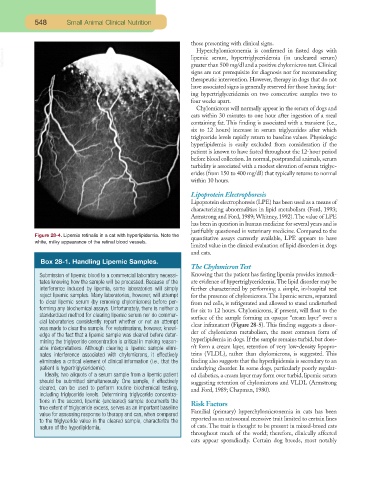Page 530 - Small Animal Clinical Nutrition 5th Edition
P. 530
548 Small Animal Clinical Nutrition
those presenting with clinical signs.
VetBooks.ir lipemic serum, hypertriglyceridemia (in uncleared serum)
Hyperchylomicronemia is confirmed in fasted dogs with
greater than 500 mg/dl and a positive chylomicron test.Clinical
signs are not prerequisite for diagnosis nor for recommending
therapeutic intervention. However, therapy in dogs that do not
have associated signs is generally reserved for those having fast-
ing hypertriglyceridemia on two consecutive samples two to
four weeks apart.
Chylomicrons will normally appear in the serum of dogs and
cats within 30 minutes to one hour after ingestion of a meal
containing fat. This finding is associated with a transient (i.e.,
six to 12 hours) increase in serum triglycerides after which
triglyceride levels rapidly return to baseline values. Physiologic
hyperlipidemia is easily excluded from consideration if the
patient is known to have fasted throughout the 12-hour period
before blood collection. In normal, postprandial animals, serum
turbidity is associated with a modest elevation of serum triglyc-
erides (from 150 to 400 mg/dl) that typically returns to normal
within 10 hours.
Lipoprotein Electrophoresis
Lipoprotein electrophoresis (LPE) has been used as a means of
characterizing abnormalities in lipid metabolism (Ford, 1993;
Armstrong and Ford, 1989; Whitney, 1992).The value of LPE
has been in question in human medicine for several years and is
justifiably questioned in veterinary medicine. Compared to the
Figure 28-4. Lipemia retinalis in a cat with hyperlipidemia. Note the
quantitative assays currently available, LPE appears to have
white, milky appearance of the retinal blood vessels.
limited value in the clinical evaluation of lipid disorders in dogs
and cats.
Box 28-1. Handling Lipemic Samples.
The Chylomicron Test
Submission of lipemic blood to a commercial laboratory necessi- Knowing that the patient has fasting lipemia provides immedi-
tates knowing how the sample will be processed. Because of the ate evidence of hypertriglyceridemia.The lipid disorder may be
interference induced by lipemia, some laboratories will simply further characterized by performing a simple, in-hospital test
reject lipemic samples. Many laboratories, however, will attempt for the presence of chylomicrons.The lipemic serum, separated
to clear lipemic serum (by removing chylomicrons) before per- from red cells, is refrigerated and allowed to stand undisturbed
forming any biochemical assays. Unfortunately, there is neither a for six to 12 hours. Chylomicrons, if present, will float to the
standardized method for clearing lipemic serum nor do commer- surface of the sample forming an opaque “cream layer” over a
cial laboratories consistently report whether or not an attempt clear infranatant (Figure 28-5). This finding suggests a disor-
was made to clear the sample. For veterinarians, however, knowl-
edge of the fact that a lipemic sample was cleared before deter- der of chylomicron metabolism, the most common form of
mining the triglyceride concentration is critical in making reason- hyperlipidemia in dogs. If the sample remains turbid, but does-
able interpretations. Although clearing a lipemic sample elimi- n’t form a cream layer, retention of very low-density lipopro-
nates interference associated with chylomicrons, it effectively teins (VLDL), rather than chylomicrons, is suggested. This
eliminates a critical element of clinical information (i.e., that the finding also suggests that the hyperlipidemia is secondary to an
patient is hypertriglyceridemic). underlying disorder. In some dogs, particularly poorly regulat-
Ideally, two aliquots of a serum sample from a lipemic patient ed diabetics, a cream layer may form over turbid, lipemic serum
should be submitted simultaneously. One sample, if effectively suggesting retention of chylomicrons and VLDL (Armstrong
cleared, can be used to perform routine biochemical testing, and Ford, 1989; Chapman, 1980).
including triglyceride levels. Determining triglyceride concentra-
tions in the second, lipemic (uncleared) sample documents the Risk Factors
true extent of triglyceride excess, serves as an important baseline
value for assessing response to therapy and can, when compared Familial (primary) hyperchylomicronemia in cats has been
to the triglyceride value in the cleared sample, characterize the reported as an autosomal recessive trait limited to certain lines
nature of the hyperlipidemia. of cats. The trait is thought to be present in mixed-breed cats
throughout much of the world; therefore, clinically affected
cats appear sporadically. Certain dog breeds, most notably

